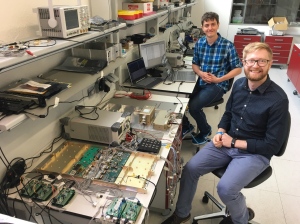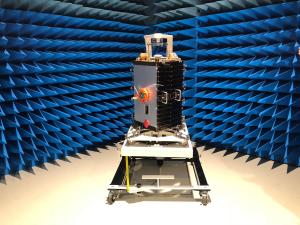AMSAT-UK will be providing a 1260/145 MHz FM transponder and a 145 MHz BPSK telemetry beacon for the European Student Earth Orbiter (ESEO). This is the third mission within the European Space Agency’s Education Satellite Programme.
The satellite, which has a mass of 50 kg and measures 33x33x63 cm, is planned to launch into a low Earth orbit.

Dr Chris Bridges M0IEB and Pete Bartram from Surrey Space Centre with the AMSAT-UK payload and some of the ESEO electronics
Nine European universities will be working with the prime contractor ALMASpace, Italy, on the mission. Cranfield University in Bedfordshire will be supplying a small sail that will be deployed to demonstrate the de-orbiting of spacecraft at the end of the mission.
The primary purpose of the AMSAT-UK payload is to provide a downlink telemetry that can be easily received by schools and colleges for educational outreach purposes. The data will be displayed in an attractive format and provide stimulation and encouragement for students to become interested in all STEM subjects in a unique way.
The target audience is primarily students at both primary and secondary levels and the project includes the development of a simple and cheap “ground station” operating on VHF frequencies in the Amateur Satellite Service. This station is an omni-directional antenna feeding a FUNcube DonglePRO+ SDR receiver which will receive the signals direct from the satellite and transfer the data to specially developed graphical software running on any Windows laptop.
Payload Functional Description
The payload will provide information about:
- On board temperatures, voltages and currents and other telemetry data available from readings taken by the payload itself and, if available, by monitoring the data available on the CAN bus.
Additional educational objectives and opportunities offered by the project include:
- “Whole Orbit Data” for orbit illumination/eclipse demonstrations.
- Speed of the spacecraft and basic orbital dynamics
- More advanced demonstrations relating to antenna radiation patterns and levels of solar radiation. Long term effects of radiation on microcircuits and other subjects would also be possible.
- Integration into the maths and physics curricula at primary and secondary levels
- Demonstrations of radio communications at schools
- Involvement of university undergraduates for more advanced studies such as “ranging”
The project will also include the development of suitable software to enable the display of the telemetry data and orbital tracking/prediction information and actual satellite attitude in an interesting and lively way. The display software will be developed in collaboration with teachers and will be available in different “flavours” to accommodate a variety of age groups. In addition to displaying the telemetry, the software will also have a live “tracking map” display with predictions for the particular school location and be capable of visually showing the spacecraft attitude and spin rates.
The payload will also enable the uploading (indirectly via a moderated host) of short greetings messages for schools to use and the deposition of the data received by a school on a central database. This central data will also be available to be retrieved by schools for display and analysis.
We envisage that inter-school competitions for, say, the most data collected in a period, the most inventive use of the data, or reports of “lessons learnt” from different age groups could be easily established with prizes and presentations.
The secondary purpose of the payload is to provide a transponder for use by individual radio amateurs around the world at night or during holiday periods. This transponder would be a single channel system using FM modulation for the 23cm uplink and 2m downlink.
The space segment will be based upon hardware and already developed for the AMSAT-UK FUNcube project (FUNcube-1, UKube-1, EO-79). The FUNcube Dongle PRO+ can be used for the ground receiver. The AMSAT-UK payload is being undertaken by an experienced team of volunteers drawn from its membership.
The space segment will consist of:
An antenna to receive signals in the amateur satellite service on two discrete frequencies in the 1260-1270 MHz band. The signals will either pass to the command receiver chain and onwards to the command decoder. Alternatively uplinked voice signals from radio amateurs will be passed through to the 145 MHz oscillator and modulator in order to be used for a single channel FM voice transponder.
Data from embedded sensors and, optionally, obtained from the data flowing on the CAN bus, will be encoded into a telemetry stream with FEC applied. This data stream will be used to modulate a BPSK carrier and fed to the 145 MHz combiner. Either or both signals will then pass to the 145 MHz amplifier chain and the transmit signal, passing through suitable filters, will go the antenna. The filter will reduce all harmonics and spurious signals to levels that will not disrupt the operation of the other RF system being used on the spacecraft.
Operational Description
An operational plan will require to be defined but it could be envisaged that after the Launch and Early Orbit Phase (LEOP) has been completed the educational payload would be operated when the spacecraft is in sunlight – when schools are most likely to active. This mode would assist the onboard power budget when other experimental payloads are operational. In later phases of the mission it might be expected that the education payload could be operated in sunlight and the amateur payload when the spacecraft is in eclipse, or, if the power budget permits, both payloads may be functional at the same time.
Ground Segment
For schools the ground segment will typically consist of a turnstile (crossed dipole) antenna with an active filter. This will feed the 145 MHz downlink signal to a FUNcube Dongle SDR PRO receiver which plugs into any Windows PC or laptop. Using such equipment, the link budget will be sufficient to enable reception of signals at a satisfactory level on all passes where the elevation exceeds 15 degrees.
For radio amateur users, similar simple equipment will suffice to listen to the FM voice downlink. Those users who wish to use the FM transponder will require about 100 watts EIRP e.g. 10 watts to an 8 element Yagi on the 1260 MHz uplink.
To display the telemetry, suitable display software will be developed together with a central data warehouse to enable schools to access data from prior orbits over the internet.
The AMSAT-UK team will also assist the development of the software for schools and support the creation of teacher aids and lesson plans to ensure the best possible benefits for school students.
IARU Coordinated Frequencies:
• Main ESEO Telemetry Beacon 437.000 MHz 4k8 or 9k6 GMSK AX25
• FUNcube-4 Beacon 145.895 MHz 4k8 BPSK
• FM Uplink 1263.500 MHz CTCSS 67 Hz
• FM Downlink 145.895 MHz
A new Dashboard has been developed for this mission and is available for download ESEO Dashboard ver 1177
The AMSAT FUNcube Payload Downlink Data document gives all the information required to decode the telemetry ESEO_Downlink_Data_1_21a
The new Dashboard will operate in exactly the same manner as those developed for previous missions and general set-up information can be downloaded here: Dashboard Guidance
A new Data Warehouse has also been created. This can be used to view the telemetry from ALL of the FUNcube missions: http://data.amsat-uk.org/missions
More information on ESEO is available from ESA Education’s website
https://www.esa.int/Education/ESEO
ESEO http://www.esa.int/Education/ESA_s_student_satellite_takes_important_step_towards_space
Student opportunities for ESEO training course
http://www.esa.int/Education/Student_opportunities_for_ESEO_training_course




You must be logged in to post a comment.